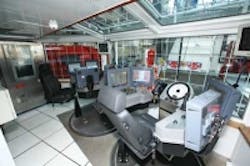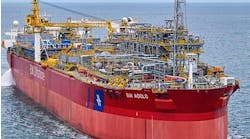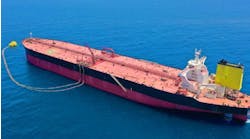David Paganie • Houston
ABS adopts new requirements for FPSOs
ABS has adopted new structural requirements for the evaluation of converted FPSOs. The criteria are contained in a revised version of the company’sGuide for Building and Classing Floating Production Installations.
ABS is taking a phased approach to revising its FPSO structural criteria: Phase 1 is for conversions and Phase 2 is for newbuilds.
“The new requirements apply FPSO-specific loading conditions and prescribed strength assessment procedures that are to be followed,” says Xiaozhi (Christina) Wang, senior managing principal engineer, ABS Corporate Technology.
ABS says the criteria allows for better prediction of environmental loads using more realistic load cases. Realistic tank load patterns as well as appropriate load combination factors were used to develop the criteria. Low cycle fatigue also was factored in, acknowledging the cyclic, more frequent loading and discharge nature of FPSOs compared to trading tankers.
In addition to varying loading patterns, FPSOs are intended to operate at a specific site for a numbers of years without dry docking. Normal maintenance, inspections, and repair are carried out on-site. To reflect this, the new standards do not require port downtime for repairs as is the case for trading tankers.
Much heavier and larger topside production facilities also are being developed for FPSOs and the new requirements outline a topside and hull interaction analysis procedure requiring finite element analysis. “The weight of the topside structure and its interaction with the hull is an important consideration,” Wang says. “Close review of the loads is needed as well as calculation of the interaction forces and their effects on the hull’s strength and fatigue life.”
Phase 2 – the upcoming newbuild criteria – includes all the features as developed for conversions such as more realistic loading cases, high cycle and low cycle fatigue strength assessment, hull girder ultimate strength assessment, and hull interaction analysis with topside structure, Wang says. The newbuild criteria is being finalized and expected to be released shortly.
COSCO to convert MT Sunrise IV
MODEC has awarded COSCO (Dalian) Shipyard a contract to convert the VLCC tankerMT Sunrise IV into an FPSO.
The contract involves repair and conversion of the 18-year-old tanker into an FPSO including topside integration and commissioning. The vessel is scheduled for delivery in mid-2010 and will be deployed on the Tupi oil field, offshore Brazil.
The FPSO will have a production capacity of 16,000 cm/d (100,000 b/d) of oil, 5,000,000 Nm³/d (177 MMcf/d) of gas, and a storage capacity of 1.6 MMbbl of oil.
Sevan construction program continues
Construction of the deepwater drilling unitSevan Driller is on schedule, according to Sevan Marine. The rig was relocated from Cosco’s Nantong Shipyard in China to the nearby Qidong Shipyard, where the derrick has been fully erected. Remaining commissioning activities will be completed there as well. Delivery is due mid-year.
Sevan says it has incurred no capex for theSevan Driller II and Sevan Driller III rigs so far this year. If the company is unable to pursue drilling contracts for the rigs, the estimated downside for both units will be $70 million, of which $22 million already has been paid.
Meanwhile, the hulls for the fourth and fifth Sevan 300 FPSOs remain under construction at China’s Jiangsu Hantong Shipyard. Sevan is seeking operational commitments for the hulls, and negotiations with the yard continue concerning the construction scope and progress.
Seven Pacific on schedule for 2010 delivery
The newbuild pipelay and construction vesselSeven Pacific is on schedule for delivery in 4Q 2010. The vessel will be fitted with a 260-metric ton (287-ton) Vertical Lay System (VLS) tower. First steel was cut on March 16, and the first units are being fabricated at IHC Krimpen Shipyard near Rotterdam.
The VLS, to be built by Schiedam-based Huisman, will include a 260-metric ton A&R (abandonment and recovery) winch with 3,000 m (9,843 ft) of A&R wire. The vessel will measure 133 m (436 ft) long, with a 24-m (79-ft) beam. In addition to the VLS, the vessel will be equipped for installing flexible flowlines and umbilicals; two 1,250-metric ton (1,378-ton) underdeck carousels; and twin 3,000-m (9,843-ft) rated ROVs.
The vessel is part of an ongoing capital investment program of over $1 billion in new assets and equipment which will see eight new vessels joining the existing Subsea 7 fleet between 2007 and 2010.
Bisso expands construction fleet; salvages sunken rig
Bisso Marine has expanded its fleet with the acquisition of the pipelay bargeG/P 37 from Global Industries. The vessel will be renamed L/B Warrior Chief.
The vessel, measuring 188 x 60 x 14 ft (57 x 18 x 4 m), is a conventional S-lay barge with four work stations, 40-kip tensioner, 525-psi Patterson jet pumping system, eight-point mooring, and accommodation for 65 people. It is configured to lay up to 20-in. (51-cm) diameter single pipeline.
Meanwhile, T&T Bisso has salvaged a 2,000-ton (1,814-metric-ton) inland drill barge capsized by Hurricane Gustav. The company designed a method to right and refloat the barge using four derrick barges and a pull barge.
Two Diamond Offshore rigs,Ocean Titan and Ocean America (pictured), have been delivered. The LeTourneau Class 64 jackup Ocean Titan entered Signal International’s East Pascagoula, Mississippi, yard for modifications and repairs on March 6 and departed on April 14. The eight-column semisubmersible Ocean America spent 97 days on Signal’s Dry Dock in Port Arthur, Texas, undergoing periodic inspection procedures and customer-planned modifications. It was delivered on May 7.
In addition to ensuring compliance with ABS special survey requirements for both rigs, upgrades and modifications to theOcean Titan included installation of an extension to the BOP control system house, fabrication of two new lifeboat platforms, and replacement of 500 ft (152 m) of leg jet piping and hangers.
Repairs and modifications toOcean America included tank cleaning; contain, blast, and paint columns, deck box, tubular supports, and derrick; removal and reinstallation of anchor chain for inspection; sacrificial anode installation; and replacement of the drilling mud treatment system. Photo courtesy of Signal International.




